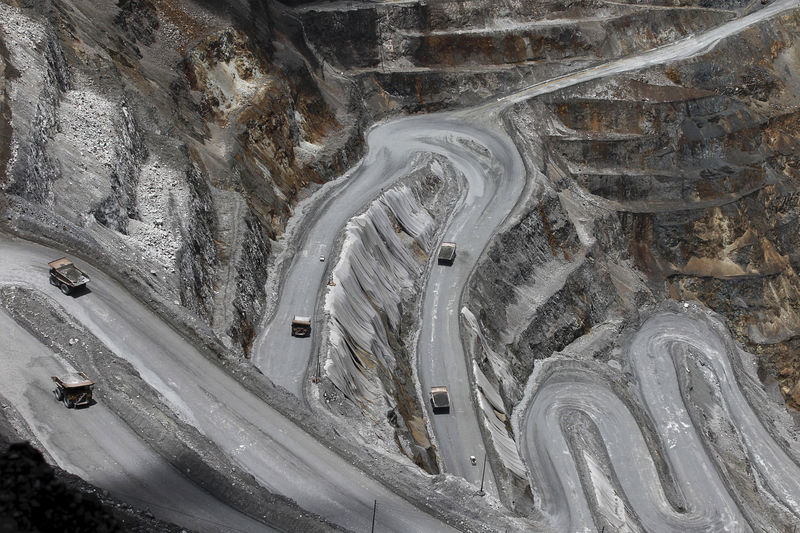* Mining recovery re-ignites exploration work
* Lack of M&A opportunities also a factor
* Hi-tech tools help to unearth next mother lode
By James Regan
SYDNEY, Feb 2 (Reuters) - After years of cutting budgets and squeezing existing mines, global mining giants are again scouting for new deposits: industry analysts say 2017 will see the first increase in spending on exploration in five years.
Exploration spending came under pressure when commodity prices tumbled and investors pushed miners to be less profligate, especially on large new projects and in untested locations.
Spending last year was down two-thirds from a 2012 peak of $21.5 billion, according to S&P Global Market Intelligence.
But mining companies say that is now changing as supply concerns return, market prices recover and deals for top-tier, low-risk mines in key commodities remain elusive.
S&P forecasts more will be spent this year in safe-bet countries such as the United States, Canada and Australia, where operating risks are lower and technology is cutting-edge.
The focus is on commodities like copper, which could slip into deficit, and on technology - to allow mining companies to find more faster, and with fewer people.
"At quiet periods in the cycle, we will typically press out into non-OECD countries," said Stephen McIntosh, group executive for growth and innovation at Rio Tinto RIO.AX RIO.L , referring to the 35-member Organisation for Economic Cooperation and Development. "But at the moment, we're focusing on the OECD, predominately the Americas, and predominately for copper."
Rio Tinto intends to spend $180-$200 million on exploration this year, and BHP Billiton BLT.L BHP.AX is boosting its exploration spending by about a third after four years in decline, mainly to find more oil and copper.
"We're looking for copper, zinc and nickel. We aren't against making acquisitions, but the assets that we're looking for just aren't there," said Andrew Michelmore, managing director of Hong Kong-listed MMG Ltd 1208.HK . "That leaves exploration."
Overall, exploration spending in Australia alone - the second-highest behind Canada - rose to A$113.8 million ($86.2 million) in the third quarter of 2016 from A$87.1 million in the first three months.
Drilling on new ground, a key indicator of exploration activity, increased 75 percent in last year's third quarter from the second quarter, according to Australia's Association of Mining and Exploration Companies.
CHEAPER, FASTER, DEEPER
Key, however, is the need to improve the hit rate, after spending ballooned during the boom but failed to translate into more discoveries. Rio Tinto reckons a Tier-1 new, or greenfield, copper discovery is made on average every four years.
Innovations such as speedier drilling analysis and on-site testing can reduce costs, and improved detection can help find ever deeper deposits. Rio Tinto has its own technology that identifies which rocks contain metals worth digging for, while others use underground drones, 3D mapping and robots to do much of the grunt work.
Companies that supply exploration equipment - from earth movers and drills to high-tech mapping services - are gearing up for more business.
"We've done a lot more training, more hiring, getting prepared for an upturn," said Denis Larocque, President of Canada-based Major Drilling Inc MDI.TO , the world's second-biggest minerals drilling company.
UK-based Adrok Ltd, in which Teck Resources Ltd TECKb.TO owns a minority stake, expects to book the most orders in years from mining majors and explorers, thanks to its atomic dielectric resonance technology, which uses electromagnetic waves to map layers and types of underground materials.
But the pressure is still on when it comes to costs.
Commodity prices have risen enough to spur greater investment in exploration, but no one is disregarding costs yet, says Adrok Chief Operating Officer Alan Goodwin. "There's more appetite for them to try new things, whereas before they were shelving a lot of projects."
($1 = 1.3203 Australian dollars)
<^^^^^^^^^^^^^^^^^^^^^^^^^^^^^^^^^^^^^^^^^^^^^^^^^^^^^^^^^^^ Mining exploration expenditure
http://tmsnrt.rs/2jeN36l
^^^^^^^^^^^^^^^^^^^^^^^^^^^^^^^^^^^^^^^^^^^^^^^^^^^^^^^^^^^>
